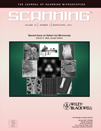Imaging and Nanofabrication With the Helium Ion Microscope of the Van Leeuwenhoek Laboratory in Delft
Contract grant sponsor: Dutch Nanoned Program; Contract grant sponsor: ASML Netherlands BV (Veldhoven); Contract grant sponsor: NXP Semiconductors (Eindhoven).
Summary
Although helium ion microscopy (HIM) was introduced only a few years ago, many new application fields are emerging. The connecting factor between these novel applications is the unique interaction of the primary helium ion beam with the sample material at and just below its surface. In particular, the HIM secondary electron signal stems from an area that is extremely well localized around the point of incidence of the primary beam. This makes the HIM well suited for both high-resolution imaging and high-resolution nanofabrication. Another advantage in nanofabrication is the low ion backscattering fraction, which leads to a weak proximity effect. The subnanometer probe size and the unique beam-materials interactions have opened new areas of research. This review presents a selection of studies conducted on a single instrument. The selection encompasses applications ranging from imaging to nanofabrication and from fundamental academic research to applied industrial developments. SCANNING 34: 90-100, 2012. © 2012 Wiley Periodicals, Inc.




